Hu Lu: Gourd – A Mascot Connecting the World
北欧国际新闻中心 亚太通讯社韩国分社消息 生在葫芦崖,从小近葫芦,亲葫芦,爱葫芦,听老人聊葫芦;长大画葫芦,收藏葫芦;当了学者研究葫芦,讴歌葫芦,他成了“葫芦痴”,甚至连笔名都确定为葫芦谐音“扈鲁”。今年,他组织主编的9卷本《葫芦文化丛书》出版,被学界誉为“填补国内外葫芦文化研究空白之力作”,成为名副其实的为葫芦立传第一人。他发起“最葫芦·葫芦文化丝路行”展演活动,成为“一带一路”宣传的名片。日前,本报记者专访了扈鲁先生。
Hu Lu was born in Huluya (gourd cliff). From his childhood, he had access to gourds and came to love the gourds. When he grew up, he began to paint and collect the gourds. Now as a scholar studying gourds, he is so obsessed with the gourds that his gave himself a pen name Hu Lu, a homophone of the gourd in Chinese. In 2018, The Gourd Culture Series (in nine volumes) he had organized to compile was published, and was praised by the academic circles as "a masterpiece filling the gaps in the study of gourd culture at home and abroad”. Hu Lu became the first to write a “biography” for gourds. He launched a series of exhibitions named “Glamour of the Gourd --- Gourd Culture Tours along the Silk Road” which became a business card for introducing the "Belt and Road". Recently, our reporter interviewed Mr. Hu Lu.
沂蒙山区有个费县,费县有个葫芦崖,传说八仙之一铁拐李的宝葫芦即采自此山。上世纪六十年代初,葫芦崖上那摇摆的葫芦丝,摇醒了一个小男孩。若干年后,这个小孩说:“我上小学时的第一幅素描作品就是画自己家门前的葫芦。”从那以后,他便与葫芦结缘。
In Huluya of Feixian County in the Yimeng mountainous area, it is said that the gourd of Tieguili, one of the legendary Eight Immortals, was taken from this mountain. Also in this place, a little boy was born in the early 1960s. A few years later, the child said: “My first sketch in the elementary school was about the gourd in front of my house.” Since then, he became attached to the gourd.
他叫扈鲁,本名扈庆学,曲阜师范大学教授。如今,他创建的葫芦画社,出版的葫芦画社报,开通的葫芦画社公众号平台和网站,筹建的葫芦文化博物馆已成为宣传葫芦文化的窗口。
The real name of Hu Lu is Hu Qingxue, a professor at Qufu Normal University. He has tried every means to promote gourd culture, the efforts including establishing the Gourd Painting Studio, publishing Gourd Painting Studio Papers, opening a WeChat Official Accounts platform and a website for the Gourd Painting Studio, and preparing for establishing the Gourd Culture Museum.

费县葫芦崖
“一带一路”与葫芦文化
The “Belt and Road” and Gourd Culture
7月6日扈鲁在《光明日报》上发表了《“一带一路”与葫芦文化》的论文,文中说,不仅我国人民喜爱葫芦,“一带一路”上的许多沿线国家人民都对葫芦与葫芦文化有共同的情感基础。一般认为葫芦的原产地是非洲,我国人民与非洲人民均有源远流长的葫芦种植历史。同时,历史文献表明,印度人民对葫芦“多子多孙”的文化寓意与中国人民有共识,蒙古的民间故事《金鹰》同样表明,葫芦在蒙古民间具有繁衍生息的含义。葫芦做为日用品和吉祥工艺品,受到“一带一路”沿线各国人民广泛喜爱。阿富汗人惯用葫芦做喜庆场合用的化妆品容器和鼻烟壶。在以色列、土耳其和一些阿拉伯国家,常见葫芦被用做烟具和装饰工艺品。甚至在美国、日本、南美洲诸国,均可见到葫芦文化的踪迹。
On July 6, 2018, an article entitled The "Belt and Road" and Gourd Culture by Hu Lu was published inGuangming Daily. The article said that the Chinese people love the gourd, so do the people in countries along the "Belt and Road”. It is generally believed that the origin of the gourd is Africa, and there has been a long history for the Chinese and African people to grow gourds. At the same time, historical documents show that like the Chinese, the Indian people have the same understanding of the cultural meaning of "multiple sons and grandchildren" conveyed by the gourds. Gold Eagle, the folktale of Mongolia, also shows that gourd is an embodiment of breeding. As daily necessities and auspicious handicrafts, the gourd is loved by people from all walks of life in countries along the “Belt and Road”. The Afghans have the habit of making cosmetic containers and snuff bottles out of gourd on festive occasions. In Israel, Turkey and some Arab countries, gourds are commonly used as smoking sets and decorative handicrafts. Gourd culture also boasts a long history in the United States, Japan, and South American countries.
7月30日,扈鲁领衔编纂的《葫芦文化丛书》,由中华书局正式出版,并受邀分别在第九届中国国际葫芦文化节、新亚欧大陆桥东方桥头堡和“一带一路”主要节点城市日照隆重举行首发式。
On July 30, 2018, the Gourd Culture Series compiled by Hu Lu was published by Zhonghua Book Company, and he was invited to attend two publishing ceremonies respectively in Huludao during the Ninth China International Gourd Culture Festival, and in Rizhao, the East Bridgehead of the New Asia-Europe Continental Bridge and a key node of the "Belt and Road".
《葫芦文化丛书》于2015年秋开始策划筹备,历时三载,参与编纂专家学者130余位。丛书共分《研究卷》《史料卷》《文学卷》《东昌府卷》等9卷,扈鲁和他的同事们将葫芦研究拓展到亚洲、非洲、欧洲、美洲等地的上百个国家和地区。用文字符号将七千多年葫芦文化载入史册,这是开拓性工程。
The preparation of the compilation of the Gourd Culture Series began in the autumn of 2015. It took three years for more than 130 experts and scholars to participate in the work. The series are divided into 9 volumes, such as The Volume of Research, The Volume of Historical Materials, The Volume of Literature, The Volume of Dongchangfu and so on. Lulu and his colleagues have expanded the gourd research to hundreds of countries and regions in Asia, Africa, Europe and America. It is a pioneering project to use language to record the 7,000 years of gourd culture history.
扈鲁正在做的,就是通过“最葫芦·葫芦文化丝路行”将《葫芦文化丛书》推广到“一带一路”沿线国家和其他喜爱葫芦文化的国度。
What Hu Lu is doing is to promote the Gourd Culture Series to the countries along the "Belt and Road" and other countries that love the gourd culture through the “Glamour of the Gourd --- Gourd Culture Tour along the Silk Road”.
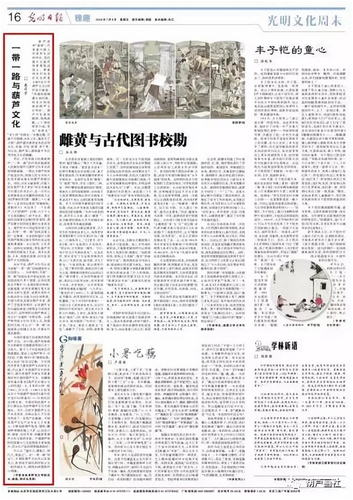
《光明日报》刊登《“一带一路”与葫芦文化》一文
数千件葫芦来自海内外
Thousands of gourds from home and abroad
葫芦文化博物馆是2010年开始筹建的。扈鲁的创建模式是先藏葫芦于书房,源源不断的葫芦,流进不大的书房,外溢到卧室、客厅、沙发、阳台、走廊,扈鲁生活的空间已经彻底被葫芦填满,但葫芦依然争先恐后地朝他这边汇聚。不得已,才产生了建个葫芦文化博物馆的想法。
The preparation of the Gourd Culture Museum was started in 2010. At the beginning, the gourds were stored in the study, and later with the increase of the collection, the gourds were stored in the bedroom, living room, sofa, balcony, and corridor, and consequently the living space of Hu Lu was completely filled. However, there are more and more gourds coming. The idea of building a Gourd Culture Museum occurred to Hu Lu.
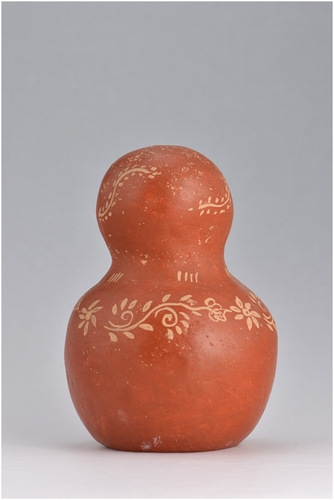
墨西哥葫芦艺术
记者问扈鲁,这么多年,到底收藏了多少葫芦了?答曰:收藏了几千件,有近百个品种,100余册(件)葫芦文化图书、音像资料,还有70余个国家和地区的葫芦艺术品……
The reporter asked Hu Lu how many gourds he had collected in these years. Hu Lu answered, “thousands of gourds of nearly one hundred species, more than 100 volumes (pieces) of gourd culture books and audio-visual materials, and gourd artworks from more than 70 countries and regions.”

越南葫芦艺术
记者曾到葫芦文化博物馆参观。那真叫眼界大开。最大的葫芦比记者还高,最小的葫芦拇指大;远远看着葫芦像集体在开会,走近前去,却鸦雀无声;仿佛在等待扈鲁的命令,要到哪里去送“福禄”;才凝神猜想葫芦的怪样儿咋长的,猛回头却又一个葫芦在逗你。大大小小的葫芦,目不暇接,或蹲,或卧,或侧,或伏,或倚,或吊于穹顶、或挂于粉墙,或藤缠于斑竹,你瞅我,我瞥你……它们有的来自异国他乡,如美国、加拿大、墨西哥、巴西、日本、韩国、土耳其、以色列、苏丹、越南、俄罗斯、意大利、马里、新西兰、肯尼亚、南非、塞尔维亚、阿根廷、秘鲁等。
The reporter visited once the Gourd Culture Museum. It was amazing. The biggest gourd was taller than the reporter, the smallest one as big as a thumb. Staying with so many gourds of various shapes and sizes, you could meditate as if you could have a good communication with them. These gourds are collected in countries such as the United States, Canada, Mexico, Brazil, Japan, South Korea, Turkey, Israel, Sudan, Vietnam, Russia, Italy, Mali, New Zealand, Kenya, South Africa, Serbia, Argentina, Peru and so on.
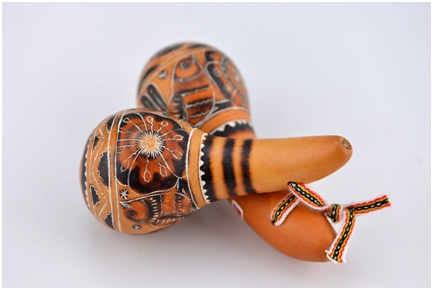
秘鲁葫芦艺术
扈鲁说:“我更看重的是不同的葫芦身上所蕴含的民俗文化,通过世界各地的葫芦文化可以窥探到不同民族的民俗文化,所以收藏葫芦是认识世界的一种方式,是增进不同民族文化交流的一种途径。”
Hu Lu said, "What I value more is the folk culture contained in different gourds. Through the gourd cultures around the world, we can have a glimpse on the folk culture of different nationalities. Therefore, collecting gourds is a way to understand the world and to promote the cultural exchanges of different nationalities.”
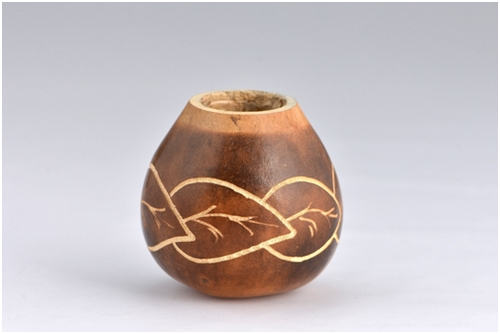
阿根廷葫芦艺术
葫芦让人跨越文化障碍
Gourd Bridges the Cultural Gap between People
2008年5月27日,扈鲁到韩国考察。在韩国一个民俗村里,一间房前挂着几个葫芦,遗憾的是这些葫芦并不对外出售。见了葫芦就忘我的扈鲁一次次找到“葫芦”主人——一位白发老者,因为语言不通,扈鲁只好用夸张的肢体语言来表达想法,手脚并用着比划,一会儿脸上就沁出汗珠,惹得老人捧腹不已。
ge, there hung a few gourds, but these gourds are not for sale. For several times, Hu Lu visited the owner — an elder man with grey hair. Because of the language barrier, Hu Lu could only express his thoughts in exaggerated body language, and the elder man could not help but laugh.
韩国老人终于懂了!那一刻,扈鲁心头一热,突然领悟,小小葫芦让两个不同国度的人跨越了文化障碍,消除了彼此的陌生感。最终,他的真诚和坚持感动了老人,买到了在韩国农耕文化中发挥重要作用的“葫芦器皿”一套。如今,它们静静地搁在葫芦文化博物馆里。
Finally, the elder man was clear of Hu Lu’s intention. At that moment, Hu Lu suddenly realized that the small gourd allowed two people from different countries to cross cultural barriers and eliminate each other's strangeness. In the end, the elder man was moved by Hu Lu’s sincerity and persistence, and agreed to sell at a high price the set of gourd utensils that had played an important role in Korean farming culture. And now, these gourds are stored in the Gourd Culture Museum.
今年10月25日至27日,来自韩国的专家学者代表团来到葫芦文化博物馆考察,扈鲁带领韩国友人参观了世界各地的藏品,异形葫芦、绾结葫芦、长颈葫芦、鸡蛋葫芦,以及用葫芦做成的象棋及各种乐器,让韩国友人目不暇接。
On October 27, 2018, a delegation of experts and scholars from Korea visited the Gourd Culture Museum. Hu Lu showed the Korean friends his collections including special-shaped gourds, knotted gourds, long-stemmed gourds, egg-gourds, as well as chess pieces and instruments made of gourds.
在一组“葫芦人生历程”泥塑前,扈鲁详细介绍了民俗文化中的葫芦元素。生、老、病、死,每一个人生节点,都有葫芦文化的习俗相伴,体现了葫芦在民间独特的文化地位。韩国友人对此表现出了浓厚的兴趣,他们在这组场景中找到了韩国结婚时踩破葫芦的民俗传统一景,他们激动地惊呼着、赞叹着。
In front of a group of clay sculptures titled “Life Accompanied by Gourds”, Hu Lu introduced in detail the gourd elements of folk culture. At different stages of life, a person is accompanied by different customs of the gourd culture, thus reflecting the unique status of a gourd in the folk culture. The Korean friends were greatly fascinated. On seeing a scene showing a Korean custom of trampling on gourds in a Korean wedding, everyone exclaimed with excitement.
在一组惟妙惟肖的拉祜族泥塑前,贯穿其中的葫芦元素引起了韩国新华报社社长曹明权先生一行的注意。扈鲁向来宾介绍了中国拉祜族的葫芦文化。拉祜族是一个自称“从葫芦里走出来的民族”,他们的始祖是从葫芦中诞生的,这个民族有一种古老的乐器——葫芦笙,拉祜族的男孩在六岁就开始学习葫芦笙,并伴随其一生。
A group of Lahu people clay sculptures characterized with gourd elements attracted the attention of the delegation headed by Cao Mingquan, Director of the South Korean Xinhua News Agency. Hu Lu introduced the gourd culture of the Chinese Lahu people to the guests. The Lahu people claim that they “have originated from the gourd”, and their first ancestors were born from the gourd. They have a traditional musical instrument, Lusheng, which Lahu boys learned to play from the age of six, and accompanied all their lives.
谈到兴起,扈鲁和曹明权一行还一起演奏起葫芦笙。大家一边吹奏,一边表演,将表演动作与拉祜族人在农田劳作的情景结合起来,葫芦这个跨越文化障碍的吉祥物熠熠闪光。
Together, Hu Lu and the delegation also played the Lusheng. While they were playing, they were acting out scenes of the Lahu people working on the farmland. Here, the gourd helped people cross cultural barriers and become friends.
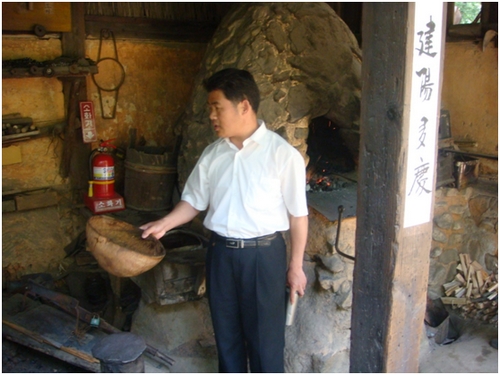
扈鲁考察韩国民俗村
“全日本爱瓢会”取自《论语》
The name of Association for All Nippon Gourd Fanciers in relation with The Analects of Confucius
以葫芦为媒,扈鲁与海外的葫芦研究学者架起了跨越国界的友谊桥。美国葫芦协会会长比尔·艾伟,美国民俗学会执行理事蒂姆·罗伊德,莫斯科州立社会人文大学副校长克拉施尼夫,英国伯明翰大学Martin Russii教授,全日本爱瓢会会长时田勉,韩国全球文化产业学会会长李永求,新加坡新中友好协会会长曾繁如……一位位国际友人慕名造访,谈文化、讲民俗。
The gourd has helped Lulu and overseas gourd researchers bridge the gaps. Foreign friends like Bill Ivey, President of the American Gourd Society, Tim Royd, Executive Director of the American Folklore Society, Krasniv, Vice President of the Russian State University for the Humanities (Moscow), Professor Martin Russii of the University of Birmingham in the UK, Tsutomu Tokida, President of Association for All Nippon Gourd Fanciers, Lee Young Koo, President of the Global Cultural Industry Association in South Korea, and Zeng Fanru, President of Singapore China Friendship Association in Singapore have visited the Museum and talked with Hu Lu about culture and folklore.
值得一提的是全日本爱瓢会会长时田勉,曾于2013年3月来曲阜参观葫芦文化博物馆,经过时田勉牵线搭桥,第39届“全日本爱瓢会”总会暨展示会特邀扈鲁组织的“最葫芦·葫芦文化丝路行”于2014年6月走进日本。
Among them, Tsutomu Tokida, President of the Association for All Nippon Gourd Fanciers visited the Gourd Culture Museum in Qufu in March 2013. With his introduction, at the invitation of the 39th General Conference of the Association for All Nippon Gourd Fanciers, “Glamour of the Gourd --- Gourd Culture Tour along the Silk Road” entered Japan in June 2014.
2015年5月,时田勉先生率团再次莅临曲阜,参观葫芦文化博物馆。这次来访,扈鲁收到了时田勉带来的一件特殊礼品:一幅印有《孔子行教图》且图旁标注“一箪食,一瓢饮,在陋巷,人不堪其忧,回也不改其乐”的图画。
In May 2015, again Tsutomu Tokida headed a delegation to visit Gourd Culture Museum in Qufu. This time he gave a special gift to Hu Lu, a picture named Confucius and His Teachings, illustrated with “What Yan Hui eats is a small basket (“箪” in Chinese or “Dan” in Chinese pinyin) of rice, what he drinks is a ladle (“瓢” in Chinese or “Piao” in Chinese pinyin) of water and where he lives is a poor house. No one else can bear such poverty and hardship. Despite the unfavorable living conditions Yan Hui still persists in his learning.”
谈到“全日本爱瓢会”这一名称的由来,时田勉解释说,在日本,葫芦不叫“葫芦”,而称为“瓢箪”,“爱瓢会”一名正是取自《论语》中“一箪食,一瓢饮”中的“瓢”字。
ciers, Tsutomu Tokida explained that in Japan, gourd is not called “Hu Lu” but Hoytan (“ヒョウタン” in Japanese, “瓢箪” in Chinese, or “Piao Dan” in Chinese pinyin), where the character “瓢”( Piao) in “爱瓢会” (Association for All Nippon Gourd Fanciers) is also selected from the phrase “a small basket (Dan) of rice and a ladle (Piao) of water” in The Analects of Confucius.
扈鲁说,中日两国一衣带水,在文化、社会、思想等诸多方面有着千丝万缕的联系,尤其是中国的德、仁、礼、信、义、智等儒家思想,对日本的政治、法律、文学、哲学、宗教及艺术等产生了广泛而深刻的影响,加速了日本的文明进程。“箪食瓢饮”这一中日两国知识分子极其相似的安贫乐道思想就是极好的例证。
China and Japan, Hu Lu said, are neighbors that are closely related in culture, society, ideology and many other aspects. The thoughts of Confucius like virtue, benevolence, rite, honesty, righteousness and wisdom, in particular, had a profound influence on Japan's politics, law, literature, philosophy, religion, art, etc., which greatly accelerated the progress of civilization in Japan. And the story of “a small basket of rice and a ladle of water” is a good example of sticking to one’s ideal and enjoying life in unfavorable conditions, which is also shared by intellectuals both in Japan and China.
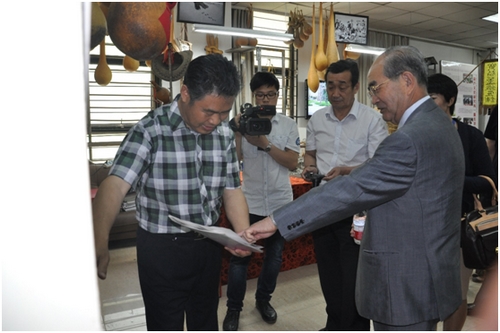
时田勉介绍瓢箪的来历
加拿大的葫芦课
Gourd Class in Canada
当地时间2017年11月30日,“最葫芦·葫芦文化丝路行”走进加拿大,在新布伦瑞克省孔子学院,扈鲁教授作了关于“葫芦文化与儒家文化”的主题演讲。
On November 30, 2017, the “Glamour of the Gourd --- Gourd Culture Tour along the Silk Road” entered Canada. At the Confucius Institute in New Brunswick, Professor Hu Lu gave a keynote speech on “Gourd Culture and Confucian Culture”.
笑容可掬的扈鲁首先拿葫芦瓢说起,葫芦一分为二即为瓢,关于瓢,《论语》中有一个“箪食瓢饮”的故事,讲的是2500多年前孔子最喜爱的弟子颜回艰苦求学的典故。颜回生活简朴,平日用竹器盛饭吃,用葫芦瓢舀水喝,住在曲阜简陋的小巷,这是别人难以忍受的艰难生活,但他依旧跟随老师孔子孜孜求学,最终取得了辉煌成就。扈鲁对孔子学院的同学们说,今天,我们的物质生活早已不像颜回时代那样匮乏,我们的精神生活也同样不能匮乏,只要大家“默而识之”“学而不厌”“敏而好学”,就一定能够学好汉语、学好中国文化。
Hu Lu started with a gourd ladle. He said that a gourd is called a ladle when it is split into halves. As for the ladle, Hu Lu told the story of “a small basket (Dan) of rice and a ladle (Piao) of water” in The Analects of Confucius. It’s about how Yan Hui, Confucius’ favorite disciple studied hard 2500 years ago. Yan Hui lived a simple life in an alley of Qufu, eating with a bamboo utensil (Dan) and drinking with a ladle, which was unbearable for others. However, in the circumstances, he followed his master Confucius, studying assiduously. Eventually he made brilliant achievements. Hu Lu told the students at the Confucius Institute that nowadays our material life is no longer as deficient as that of Yan Hui’s time, nor should be our cultural life. Everyone is sure to learn Chinese and Chinese culture well as long as he is keen on learning and insatiable in learning and learns in a down-to-earth way.
接着,他又告诉大家,葫芦分甜葫芦和苦葫芦。《诗经·幽风》:“七月食瓜,八月断壶。”这里所说的食瓜,即农历七月就可以食用甜葫芦了,而苦葫芦是不能大量食用的,否则会导致身体中毒。《论语》中有一个故事就谈到了苦葫芦。《论语·阳货》:“吾岂匏瓜也哉?焉能系而不食?”即:“我难道是个苦葫芦吗?怎么能够只挂在那里而不让食用呢?”
Then he said that gourds are divided into sweet and bitter gourds. Youfeng in The Book of Songs reads, “Eat melon in July, and pick gourd in August.” Here eating melon in July means that the sweet gourd can be eaten in the seventh lunar month, while the bitter gourd cannot be eaten in large quantities. Otherwise, poisoning might occur. There is a story about the bitter gourd in The Analects of Confucius.Yang Huo in The Analects of Confucius reads: Am I a bitter gourd that can only be used as an ornament instead of food that can be eaten?”
扈鲁幽默的讲述,引起阵阵笑声。加拿大教育官员Kimberly女士,现场通过手机图像同扈鲁分享了她爱人创作的葫芦艺术品,交流葫芦艺术创作心得。
The humorous story aroused laughter. Ms. Kimberly, the Canadian education official shared pictures in her mobile phone of her husband’s gourd works with Hu Lu and exchanged her experience of gourd art creation with him.
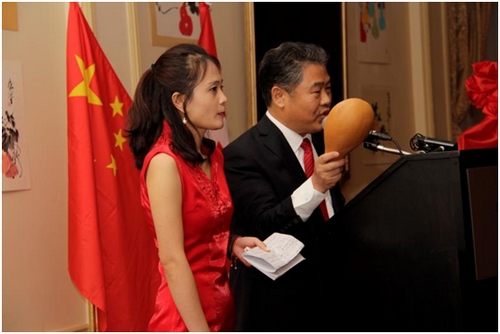
扈鲁在加拿大讲授葫芦课
大洋挡不住的回声
Echo Transcending the Oceans
就在那次扈鲁演讲的间隙,新布伦瑞克省教育厅官员Kimberly说她先生John Bauer是小学的法语教师,先生的父亲就喜欢种葫芦,所以她的先生从小也是在葫芦上画画儿。
Just in the middle of the speech by Hu Lu, Ms. Kimberly, an official in the New Brunswick Department of Education said that her husband John Bauer taught French at an elementary school, and his father Loved to grow gourds, so her husband painted on the gourd from an early age.
今年7月,加拿大新布伦瑞克省孔子学院加方院长滕菁带着校长团到访曲阜师大,校长们被葫芦文化博物馆里的大小不一,形式各样的葫芦所震撼,滕菁在谈到那位法语老师的葫芦作品时,扈鲁说:我希望购买过来。滕菁回到加拿大后,跟Kimberly,也就是John Bauer的妻子,转达了扈鲁欲购买作品的愿望。她微笑着“拒绝”——不会卖的,但可以送给扈鲁先生。
In July 2018, a principal delegation headed by Teng Jing, the dean of the Confucius Institute in New Brunswick, Canada, visited Qufu Normal University. The principals were fascinated by the gourds of various sizes and shapes in the Gourd Culture Museum. When Jing Qing talked about the gourd works by the French teacher, Hu Lu expressed his desire to purchase them. After Teng Jing returned to Canada, she conveyed to Kimberly, the wife of John Bauer, the desire of Lulu to purchase John’s works. She smiled, “No, it is not for sale, but we can give it to Mr. Hu Lu.
8月9日,滕菁再次回中国的前一晚,Kimberly和她先生John Bauer及儿子一起来到滕菁家,小心翼翼地把一个包装好的盒子打开,里面有两个精美的葫芦,每个大约十厘米高。Kimberly详细介绍了这两个葫芦,其中花色的是她先生John画的,绿色的是John父亲的作品。John的父亲是新布伦瑞克大学的教授,一生中业余爱好就是喜欢种葫芦,并在葫芦上作画。这时John风趣地插上一句,“我原来一直觉得我爸爸是葫芦国王,没想到扈鲁先生才是真正的葫芦王。”
The night before Teng Jing went to China in this early August, Kimberly, together with her husband John Bauer and their son, came to Teng Jing’s home with a box containing two exquisite gourds, each being 10cm high. According to Kimberly, the colored one was made by John and the green one was made by John’s father who was a professor at UNB University and fond of planting gourds and painting on them in his spare time. At that time, John said humorously, “I used to regard my father as the king of gourd, but now I think Hu Lu from China is the real king of gourd.”
遗憾的是,John的父亲2010年去世了,无法亲见中国的葫芦。当John的母亲听说John 的葫芦要送去中国,她专程从别的城市开车赶赴儿子家,送来了John父亲当年的作品。
Regrettably, John's father died in 2010 and could not see the Chinese gourd. When John’s mother heard that John’s gourd would be taken to China, she drove from another city to her son’s home and brought the work of John’s father
他们还写了热情洋溢的贺卡,贺卡上有著名美国作家库尔特·冯内古特(Kurt Vonnegut)的一行字:“生活中的小事情可以成就大事件(The little things in life are the big things)。”
They also wrote a card containing a line of famous American writer Kurt Vonnegut, “The little things in life are big things. ”
8月10日,滕菁回中国,一路上把这个小盒子一直放到随身携带的手提包里,时不时地打开看看别把葫芦损坏了。在首届全球孔子学院山东文化旅游推广峰会上,滕菁向来自五个国家的嘉宾以及台下各位来宾们,讲述了她手中这两个葫芦的故事。
In August 10, Teng Jing went to China. She carried the box in her handbag and opened it from time to time to see whether the gourds were in good condition. In Qufu, Teng Jing attended the First Global Confucius Institute Shandong Cultural Tourism Summit where she told the guests from five countries the story of the two gourds.
临离开曲阜,滕菁把两只精致的葫芦送给了扈鲁夫妇,扈鲁夫妇回赠了精心创作漂亮大气的葫芦画,希望滕菁带给John Bauer。
When leaving Qufu, Teng Jing presented the two exquisite gourds to Hu Lu and his wife, and the couple presented in return a magnificent gourd painting they had created, hoping that Teng Jing would take it to John Bauer.
